The Beacon | The Last Mile of Disinflation
Why the easy phase is over — and what it means for the next stage of policy, markets, and growth.
Lighthouse Macro
Macro, Illuminated.
A New Rhythm
After several weeks rebuilding my research process and workflow, Lighthouse Macro relaunches today with a consistent publishing cadence structured around how I analyze and trade global macro themes.
Each element has a defined role:
Sundays → The Beacon — deep dives on major macro themes, built around data, charts, and structured argument.
Tuesdays & Thursdays → The Beam — concise, chart-led insights: one chart, one key takeaway, one narrative.
Fridays → The Chartbook — dozens of charts summarizing the week’s data and market action.
First Monday of Each Month → The Horizon — forward-looking cross-asset outlook connecting the cycle to positioning.
Programming note: I’m publishing The Beacon on Monday this week to get it out the door; Sundays going forward.
That rhythm begins this week. Today’s edition of The Beacon examines the challenge facing policymakers and investors alike—the last mile of disinflation.
The Last Mile of Disinflation
Inflation has moved from background variable to central macro constraint.
The pandemic shock was largely demand-driven, amplified by supply chain fragilities and energy disruptions. Goods inflation has reversed sharply, but services remain stubbornly elevated. Wages, shelter, and structural demographic forces make the final stretch, from roughly 3% back to the Fed’s 2% target, the hardest part of the journey.
The key risk facing markets and policymakers: inflation stabilizes above target, near 3%, forcing a fundamental repricing of policy expectations and asset valuations. This would represent not a return to the 2010s regime of chronically subdued inflation, but rather a new equilibrium — one that constrains fiscal space, maintains restrictive real rates, and reshapes cross-asset dynamics for years to come.
1. The Great Constraint Returns
Through the 2010s, inflation stayed subdued across developed economies. U.S. headline CPI averaged near 2%, core PCE consistently undershot the Fed’s symmetric target, Europe flirted with deflation, and Japan endured another lost decade of stagnant prices and nominal growth.
Central banks deployed unprecedented monetary accommodation — zero rates, negative policy rates in Europe and Japan, multiple rounds of quantitative easing — yet inflation remained dormant. The Phillips curve appeared broken; the relationship between unemployment and inflation had flattened to near irrelevance. Investors built portfolios around a foundational assumption: inflation would never matter again as a binding constraint on growth or policy.
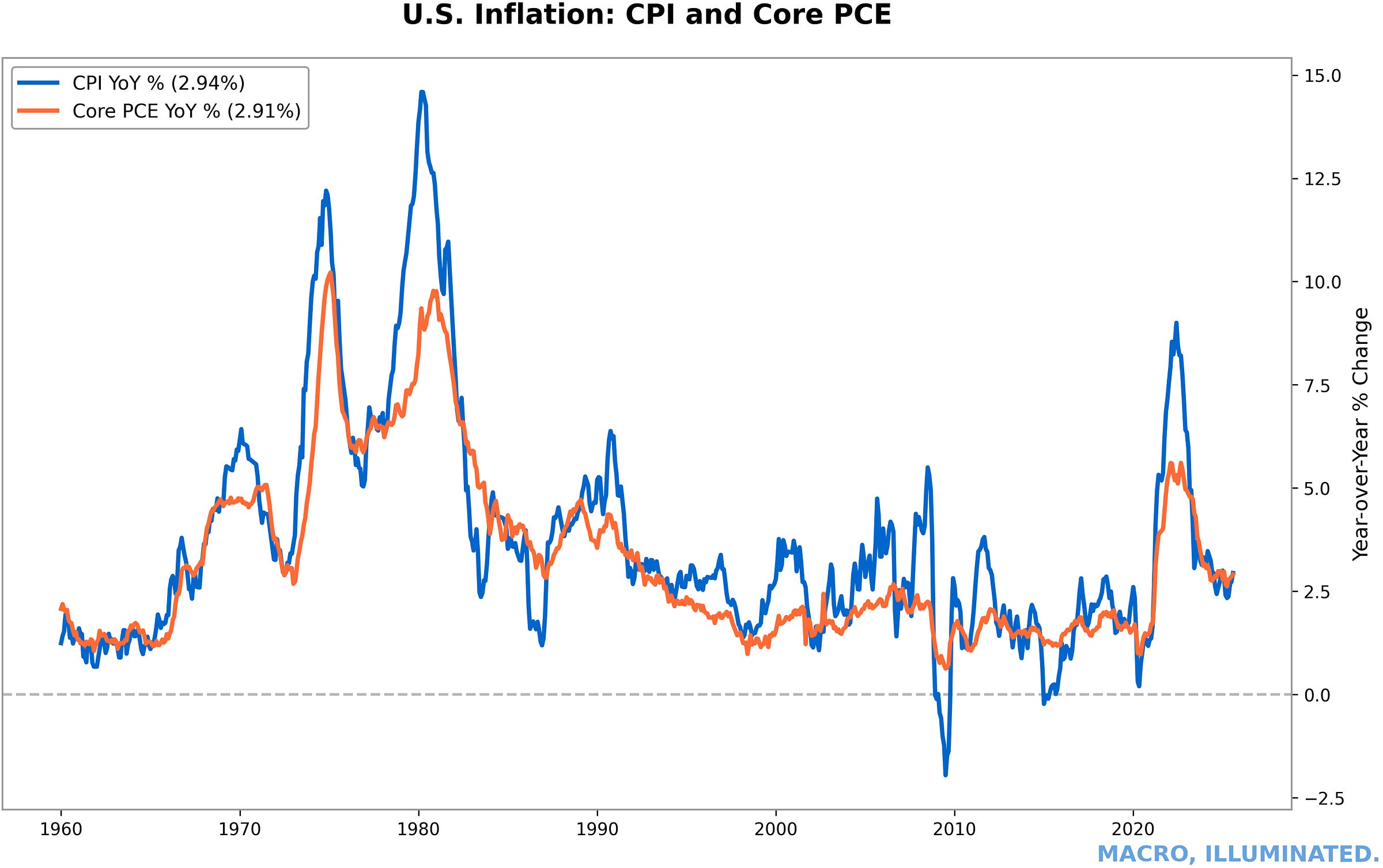
Chart 1: U.S. Inflation — CPI and Core PCE (Full History) The 2021-2022 inflation surge represents the most significant departure from the 2% target since the Volcker era, raising the critical question of whether inflation settles at 2% or stabilizes near 3%.That world ended abruptly in 2021. Headline CPI surged past 9% in June 2022 — the highest reading in four decades, rivaling the early 1980s Volcker era. Core PCE, the Fed’s preferred gauge, followed suit, overshooting the 2% target by the widest margin in a generation.
The 2021-2022 inflation shock wasn’t merely a temporary deviation. It represented a regime shift: Inflation moved from irrelevant background noise to the dominant constraint on policy, growth, and fiscal sustainability. The Federal Reserve pivoted from worrying about chronically low inflation to fighting the most acute price pressures since Paul Volcker’s tenure.
The question now isn’t whether the 2021-2022 spike was “transitory”, that debate is settled, and the answer was no. The live issue is where inflation settles: back at the 2% target that anchored the 2010s, or closer to 3%, establishing a new, higher equilibrium. That outcome will shape monetary policy trajectories, fiscal sustainability, bond market pricing, and equity valuations for years.
2. The Shock That Changed Everything
2.1 Demand Overshoot: Fiscal Transfers at Unprecedented Scale
The COVID recession was unique in economic history. Rather than income collapsing, the normal pattern in recessions, household incomes surged through massive, front-loaded fiscal transfers. Direct payments, enhanced unemployment benefits, PPP loans, expanded child tax credits, and emergency rental assistance pumped trillions into household balance sheets over 18 months.
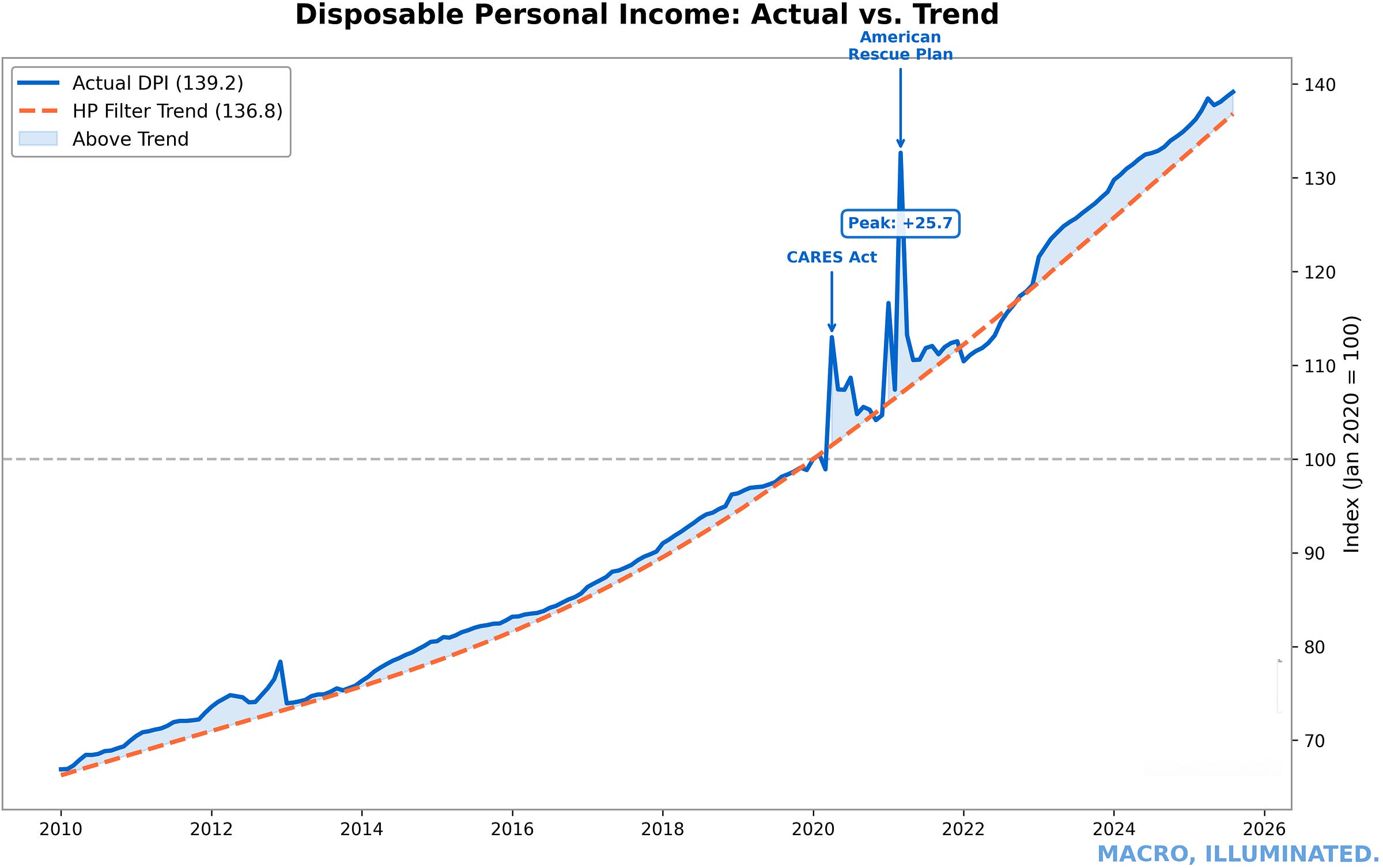
Chart 2: Disposable Personal Income — HP Trend (2010-present) Disposable income surged 15-20% above trend during peak fiscal support — the inverse of a typical recession — creating unprecedented demand-side inflationary pressure.The fiscal boost — visible in the widening gap between total disposable income and income excluding transfers — created a powerful rebound in aggregate demand. When pandemic restrictions lifted in 2021, pent-up demand collided with constrained supply. Too much money chasing too few goods: the textbook definition of demand-pull inflation.
This demand overshoot was intentional policy. Policymakers prioritized avoiding the mistakes of 2008-2009, when inadequate fiscal support produced a slow, grinding recovery with persistent unemployment. The 2020-2021 fiscal response erred in the opposite direction — delivering too much stimulus relative to supply capacity, igniting inflation but also ensuring a rapid return to full employment.
2.2 Supply Under Strain: Fragile Global Networks
Supply capacity buckled under the demand surge. Global shipping networks, optimized for just-in-time logistics and low inventory buffers, proved brittle when stressed.
Ports clogged with containers, semiconductor shortages paralyzed auto production, shipping costs exploded 10x normal levels, and delivery times lengthened from weeks to months. Backlogs built across manufacturing and distribution networks. The Global Supply Chain Pressure Index, maintained by the New York Fed, surged to record highs in late 2021.
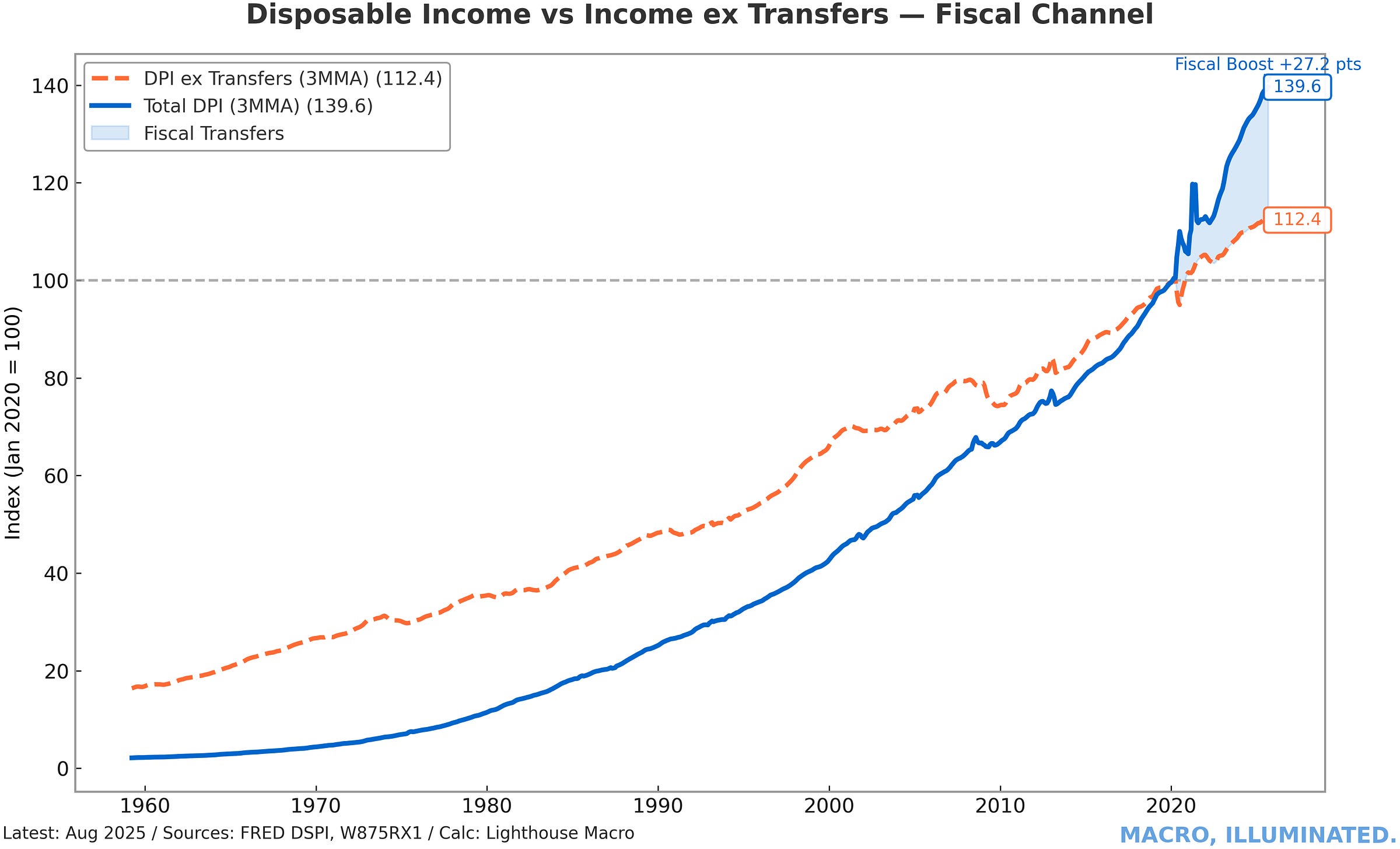
Supply chain pressures led core goods inflation by roughly 5 months, demonstrating the causal link. But by mid-2022, supply chains had largely normalized — the GSCPI returned to pre-pandemic levels, yet core goods inflation remained elevated through 2023. This divergence reveals an important truth: supply chain disruptions amplified the inflation surge but were not the root cause. Demand was doing the heavy lifting.
2.3 Energy and Food Shocks: Geopolitical Multipliers
As supply chains began healing in late 2021 and early 2022, Russia’s invasion of Ukraine on February 24, 2022 layered on a severe global energy and food shock. Oil, natural gas, and grain prices surged, transmitting inflationary impulses globally.
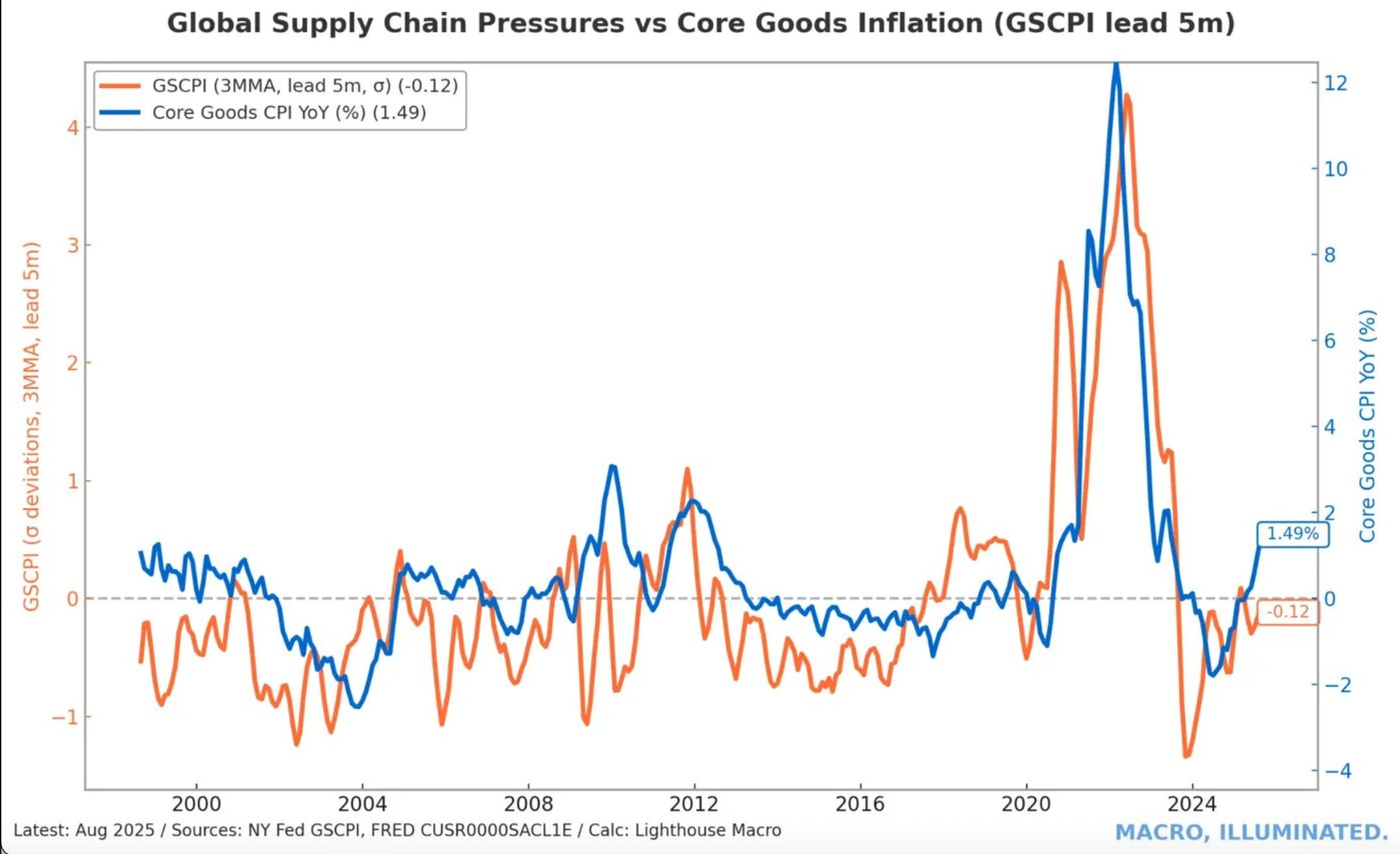
Chart 4: Global Supply Chain Pressures vs. Core Goods Inflation Supply chain pressures normalized by mid-2022 while inflation persisted, confirming demand — not supply disruptions — drove the sustained inflation surge.Brent crude oil climbed toward $130/barrel in March 2022. European natural gas prices, measured by the Dutch TTF benchmark, exploded to €360/MWh (roughly $500/barrel of oil equivalent), a 6-7x increase from pre-invasion levels. Energy inflation fed through to food prices (via fertilizer costs and production inputs), transportation costs, and goods prices more broadly.
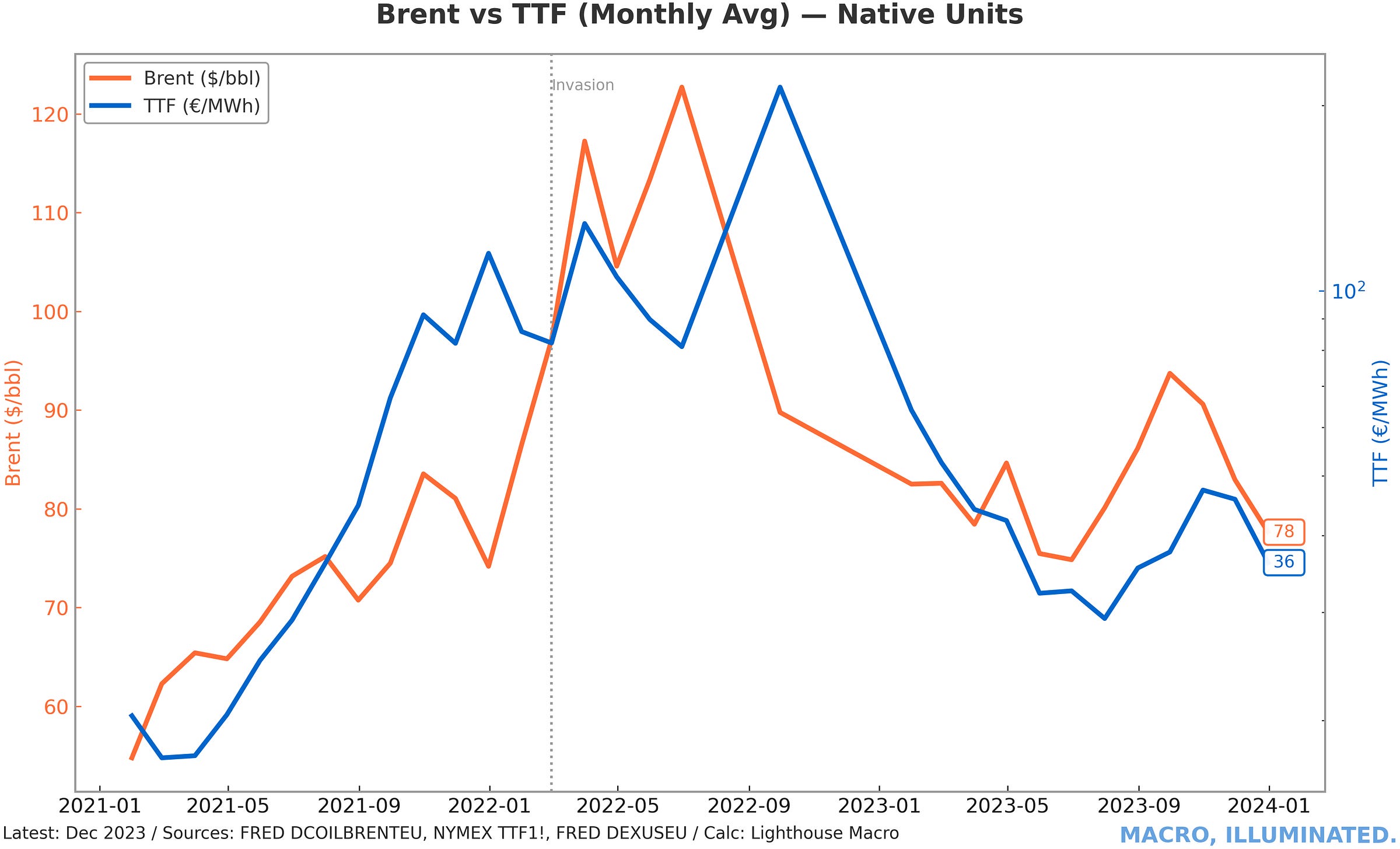
Chart 5: Brent Oil vs. European Natural Gas (TTF) — Native Units Russia’s invasion triggered an asymmetric energy shock with European natural gas spiking to €360/MWh (10x normal) while oil peaked near $130/barrel, extending the inflationary cycle through 2022.The energy shock kept headline inflation elevated throughout 2022 even as goods price pressures began normalizing. It also created a significant divergence between U.S. and European inflation dynamics. Europe faced a more severe and persistent energy-driven shock due to reliance on Russian pipeline gas.
3. The Anatomy of the Inflation Surge
3.1 Demand vs. Supply: What Research Tells Us
Most rigorous economic research attributes the bulk of the 2021-2023 inflation surge to excess aggregate demand, with supply disruptions and energy shocks acting as multipliers rather than root causes.
Federal Reserve staff analysis, academic studies from institutions like the San Francisco Fed and the National Bureau of Economic Research, and international comparisons all point to the same conclusion: fiscal stimulus-driven demand exceeded supply capacity, and that excess demand drove the persistent component of inflation.
The evidence: as supply chain pressures normalized in 2022-2023, inflation did not collapse. Goods inflation cooled, but services inflation — the labor-intensive, domestically-produced component — remained sticky. This pattern is inconsistent with a primarily supply-driven shock (which would reverse when supply heals) but consistent with demand-driven inflation (which persists until demand cools or supply expands).
3.2 Goods vs. Services: The Great Divergence
Goods inflation is volatile and self-correcting; services inflation is sticky and persistent. This divergence defines the current phase of the cycle.
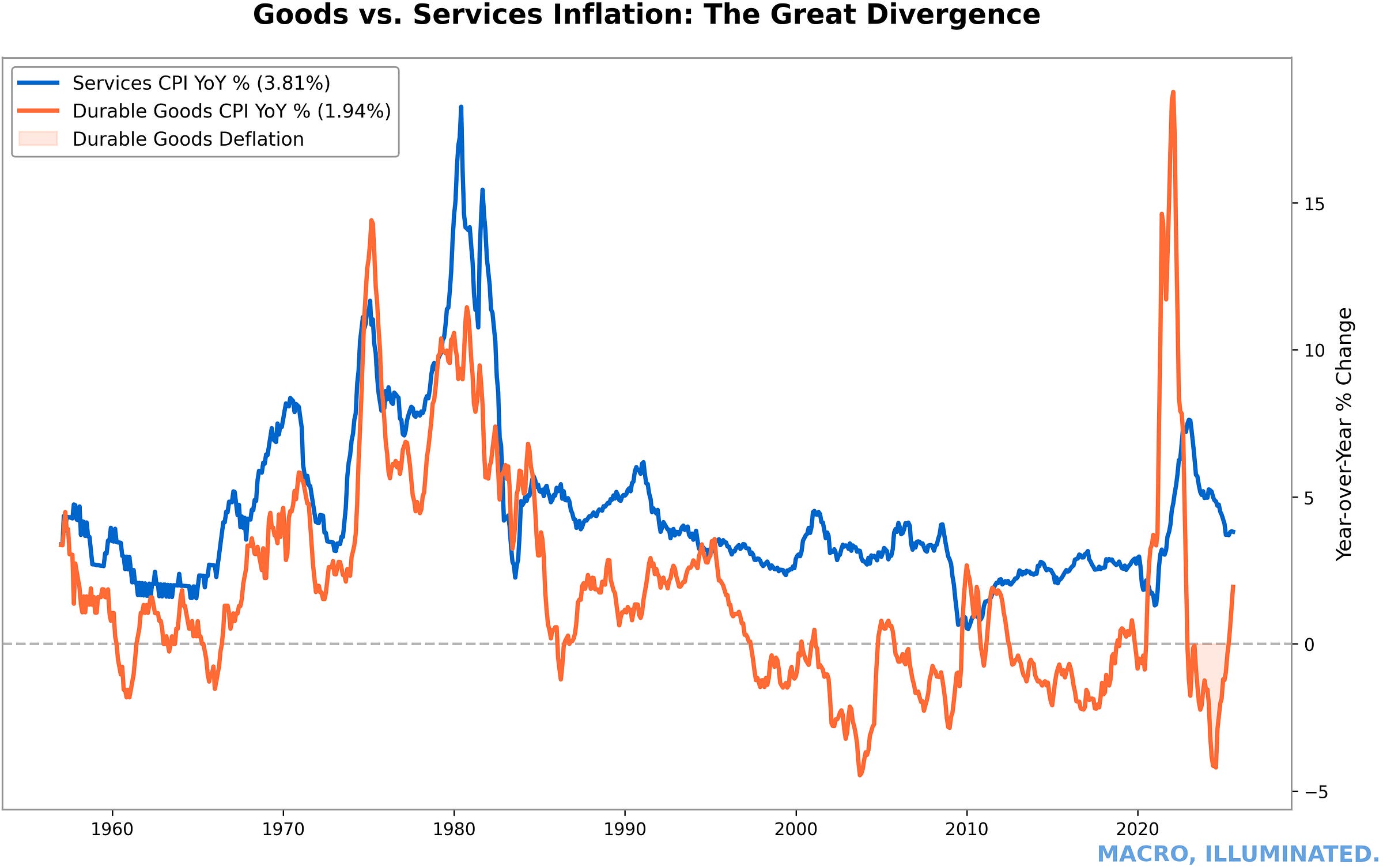
Chart 6: Goods vs. Services Inflation — The Great Divergence Durable goods inflation has reversed into deflation while services remain anchored near 4% YoY, isolating labor-intensive services as the binding constraint on returning to the 2% target.Durable goods inflation surged to 18% year-over-year in early 2022 — driven by used cars, appliances, electronics, and furniture — then collapsed into outright deflation by 2024. Durable goods prices are now falling year-over-year, subtracting from headline CPI.
Services inflation, by contrast, never followed goods lower. Services CPI remains near 4% year-over-year — double the pre-pandemic pace. Rents, healthcare, auto insurance, restaurant meals, and other labor-intensive services keep inflation anchored well above the Fed’s target.
This divergence reflects structural differences: goods prices are set in globally integrated markets with elastic supply, while services prices are set in local labor markets with inelastic supply. Goods inflation self-corrects quickly; services inflation requires labor market slack to cool.
4. From Peak to the Last Mile
4.1 Goods Reversal: Deflation in Durables
The goods side of inflation has flipped decisively. Durable goods prices — cars, appliances, electronics, furniture — now subtract from headline CPI on a year-over-year basis.
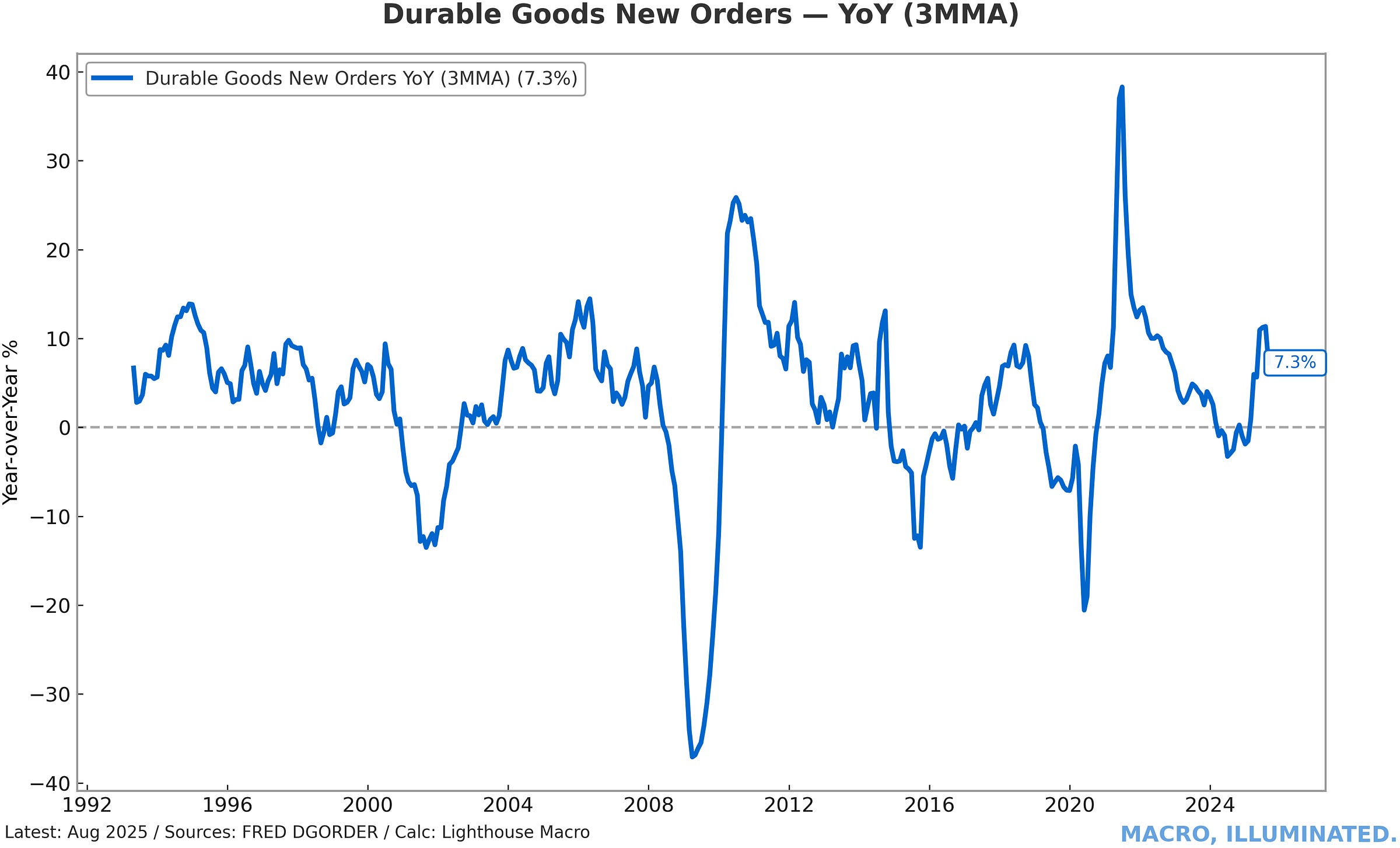
Chart 7: Durable Goods New Orders — YoY (3-Month Moving Average) Durable goods orders have normalized to pre-pandemic growth rates, signaling the demand overshoot that drove goods inflation has fully unwound.Durable goods orders have normalized after the pandemic surge, signaling cooling demand. Inventories have rebuilt, supply chains have healed, and pandemic-era premiums (like the used car markup) have evaporated.
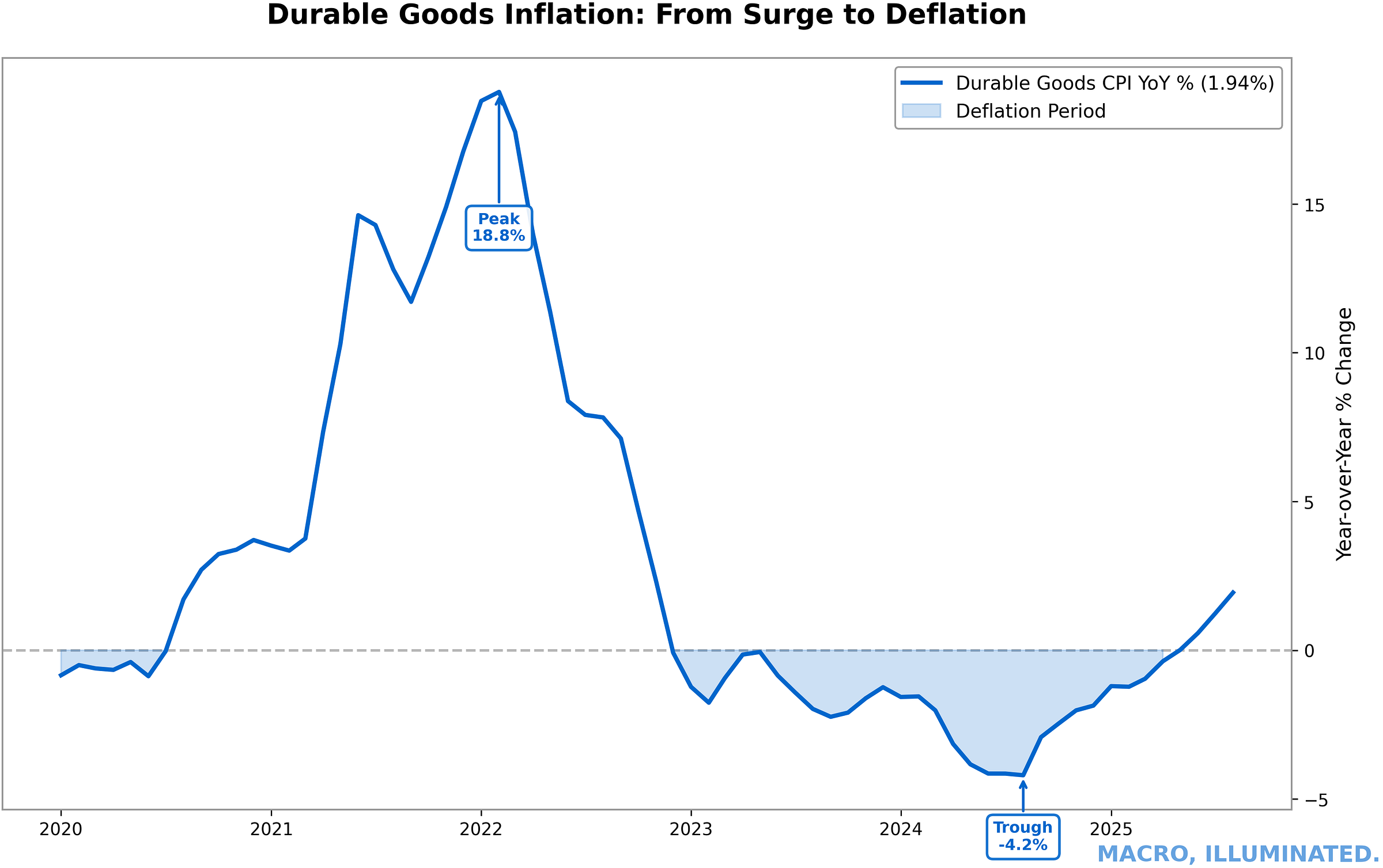
Chart 8: Durable Goods Inflation — From Surge to Deflation The 23 percentage point swing from +18.8% to -4.2% represents the most dramatic goods price reversal since 1950, effectively solving the goods component of inflation.Durable goods CPI peaked at 18.8% year-over-year in early 2022. By late 2024, it had turned negative, reaching -4.2%. The goods inflation problem is solved. Goods are no longer the source of inflationary pressure — they’re now a disinflation headwind.
4.2 Wages: Cooling but Still Elevated
Labor markets are cooling, but wage growth remains above pre-pandemic norms, feeding services inflation.

Chart 9: Wages vs. Core Services ex Shelter — YoY Average hourly earnings at 4% YoY drive services inflation near 4%, revealing the tight contemporaneous link between labor costs and the persistent component of inflation.Average hourly earnings growth has decelerated from the 8% peak in 2022 but remains near 4% year-over-year — well above the 2-2.5% pace consistent with 2% inflation. Core services inflation excluding shelter tracks wage growth with a short lag, reflecting the labor-intensive nature of services production.
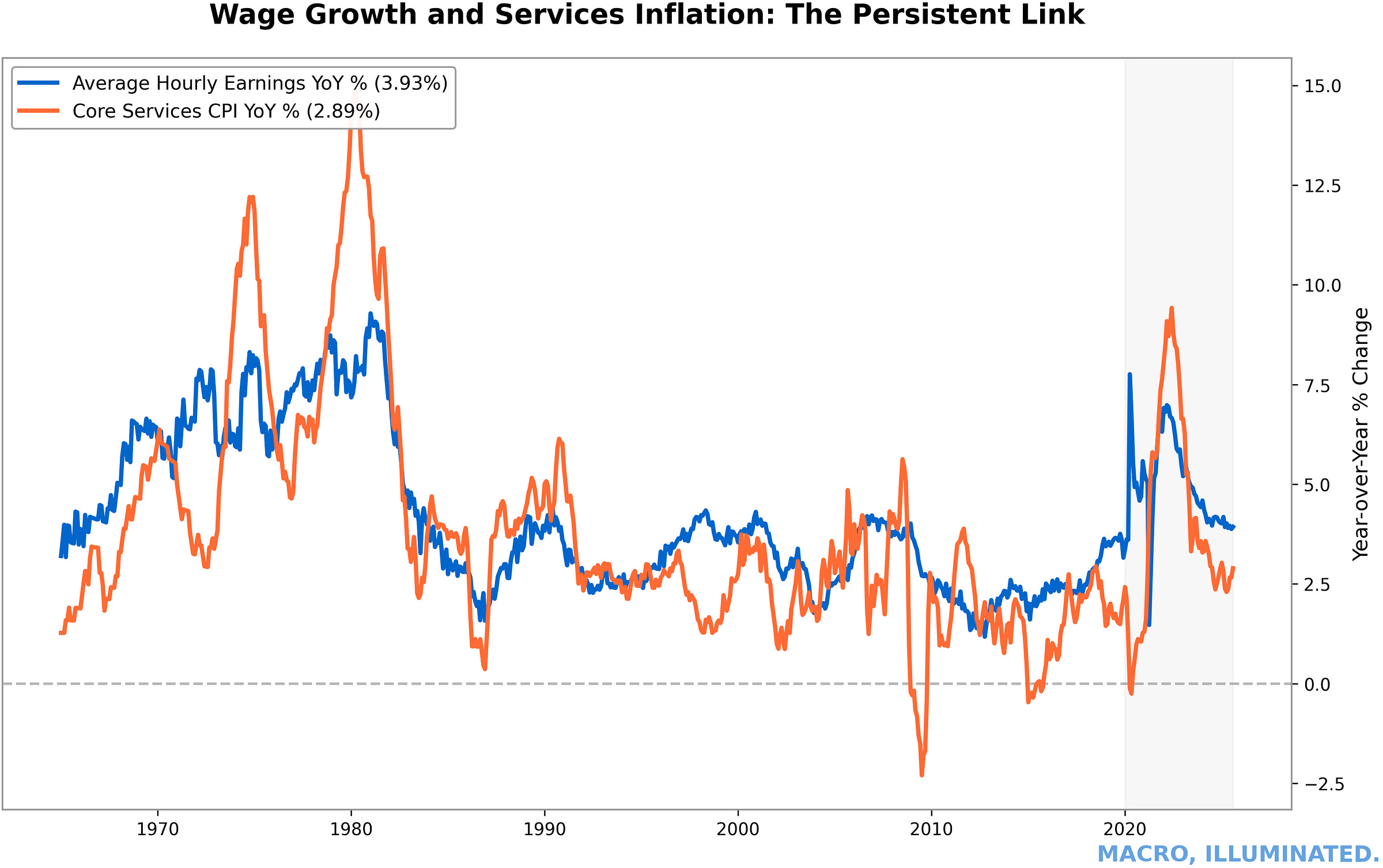
Chart 10: Wage Growth and Services Inflation — The Persistent Link (Long History) The Phillips curve relationship between wages and services inflation — dormant in the 2010s — has reasserted with the strongest correlation since the 1990s, making wage deceleration critical to disinflation.The long-run relationship between wage growth and services inflation has historically been tight. Wage growth near 4% is inconsistent with services inflation returning to the 2% target. Either wages must cool further, or productivity growth must accelerate to absorb higher labor costs without passing them through to prices.
4.3 Shelter Stickiness: The Lag Problem
Shelter inflation — which accounts for roughly one-third of headline CPI — remains the single largest contributor to inflation persistence. But shelter inflation is misleading due to severe measurement lags.Private market data from Zillow (asking rents) and the BLS’s Rent of Primary Residence (RPR) survey show that new lease rents have cooled significantly — Zillow’s observed rent index has decelerated from 16% YoY to under 3% YoY.
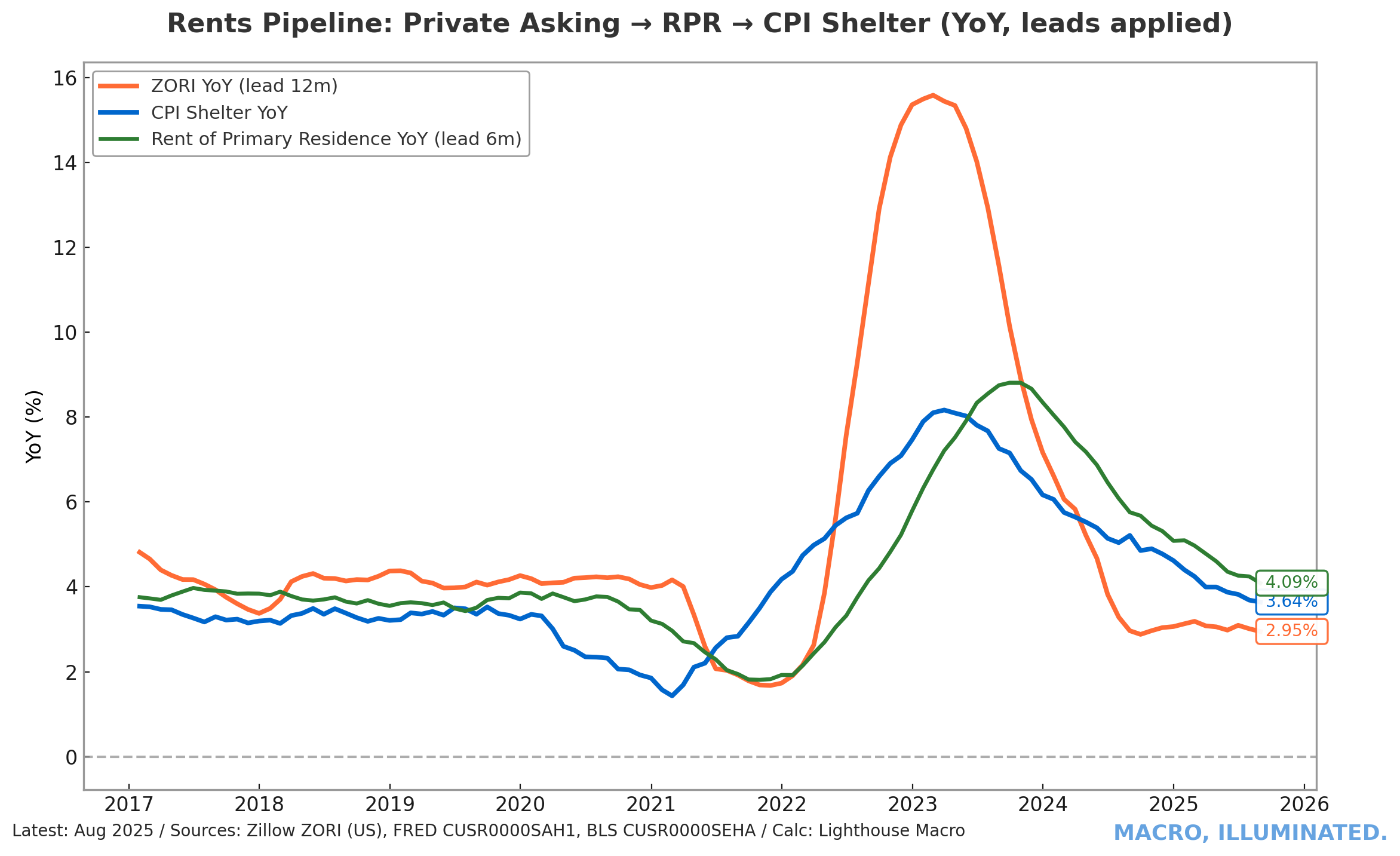
Chart 11: Rents Pipeline — Private Asking Rents → RPR → CPI Shelter Private market rents have cooled to 3% YoY while CPI shelter lags at 4.8% due to the 12-18 month stock-flow problem, creating ~1pp of “phantom” inflation that will mechanically fade through 2025.CPI shelter lags private market data by 12-18 months due to the stock-flow problem—it measures rents across all existing leases, not just new lease signings. Most leases renew annually, so it takes time for cooler new lease growth to filter through to the aggregate index.
CPI shelter inflation peaked at 8.2% YoY in early 2023 and has since decelerated to ~4% YoY. But the pipeline suggests further deceleration ahead — CPI shelter should converge toward the 3% pace observed in private market data over the next 6-9 months.
This lag creates a persistent drag on measured inflation, even though the economics of housing inflation have already cooled. It’s a data artifact, not an economic reality.
4.4 Labor Market Slack: The Key Variable
The unemployment rate is the critical variable determining the speed of services disinflation.

Chart 12: Unemployment Rate vs. Core Services ex Shelter — Best Lag Alignment Unemployment leads services inflation by one month with a -0.38 correlation, suggesting current labor market conditions (4.2% unemployment) are consistent with 4% services inflation — not the 2% target.The unemployment rate leads core services inflation by roughly 1 month, with a negative correlation of -0.38. Rising unemployment cools services inflation; falling unemployment heats it up. This Phillips curve relationship — dormant in the 2010s — has reasserted itself in the 2020s.
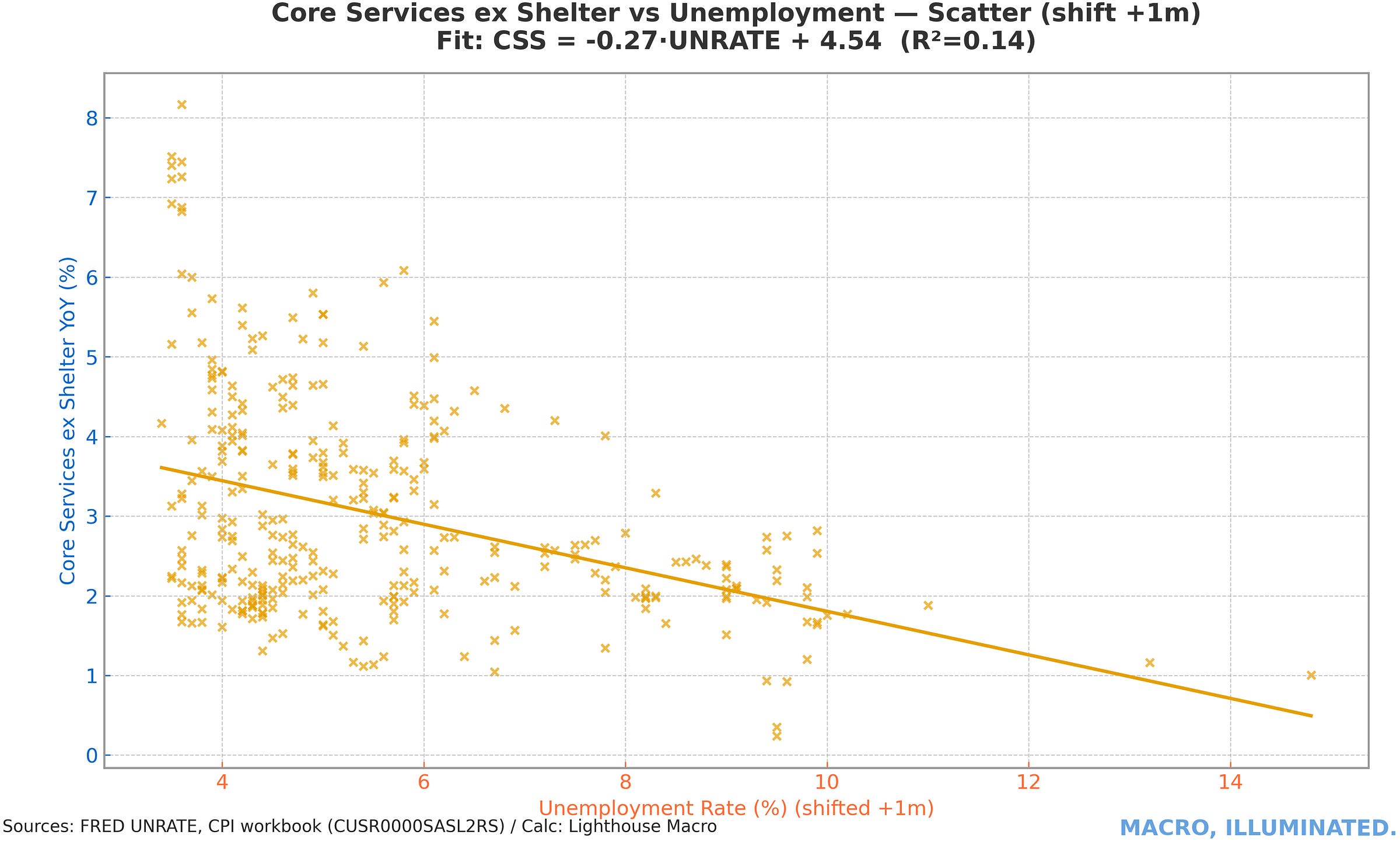
Chart 13: Core Services ex Shelter vs. Unemployment — Scatter Plot The revived Phillips curve reveals that reaching 2% services inflation likely requires unemployment rising toward 4.5-5.0%, defining the narrow path for a soft landing.The scatter plot reveals the inverse relationship: services inflation peaks when unemployment troughs, and vice versa. Current unemployment near 4.2% is consistent with services inflation near 4% — not the 2% pace required for overall inflation to return to target.
For services inflation to reach 2%, unemployment likely needs to rise modestly toward 4.5-5.0%, creating enough labor market slack to cool wage pressures without triggering a recession. This is the narrow path the Fed is attempting to navigate — the “soft landing” scenario.
5. Policy at the Edge of Balance
5.1 The Fed’s Historic Tightening Cycle
The Fed’s 2022-2023 tightening campaign was the fastest since Paul Volcker’s tenure in the early 1980s.

Chart 14: Federal Funds Rate — The Fastest Tightening Since Volcker The 525 basis point hike in 16 months represents the most aggressive tightening since the early 1980s, with lag effects still filtering through the economy and historical precedent suggesting soft landings are rare.The Fed hiked from the zero lower bound (0.05%) to a peak of 5.33% in just 16 months — the most aggressive pace of tightening in four decades. Real interest rates (adjusted for inflation) turned decisively positive, moving from deeply negative in 2021 to +2.0-2.5% by mid-2023.
This tightening has worked — inflation has decelerated from 9% to ~3%, and the labor market has cooled without collapsing. But the lag effects of monetary policy mean the full impact is still filtering through to the economy.
The Fed now faces a difficult balancing act:
Ease too soon, and inflation revives — particularly if fiscal policy remains expansionary or external shocks (energy, geopolitics) reignite price pressures
Stay too tight too long, and growth cracks — unemployment rises sharply, credit markets freeze, and the economy tips into recession
The market is pricing in a “soft landing” — inflation returns to target without a recession. But history suggests this is the lowest-probability outcome. Soft landings are rare; economic cycles typically end in either overheating (if policy eases prematurely) or recession (if policy stays restrictive too long).
5.2 Fiscal Constraints Tighten
Fiscal policy is tightening as well, though the mechanism differs from monetary policy. Rising interest rates have dramatically increased federal interest expense.
Interest expense as a percentage of GDP has surged from 1.5% in 2021 to over 3.5% by 2024 — the highest since the 1990s. With debt-to-GDP near 120%, every 100 basis points of higher rates adds roughly $300 billion in annual interest costs.
This tightening of fiscal space constrains future policy flexibility. If a recession arrives, fiscal policymakers will have less room to deploy large-scale stimulus programs like those in 2008-2009 or 2020-2021. The fiscal ammunition has been partially spent.
Moreover, higher interest costs crowd out discretionary spending unless lawmakers are willing to raise taxes or tolerate even higher deficits. This creates a binding fiscal constraint that wasn’t present in the 2010s, when near-zero rates made debt service trivially cheap.
6. Structural Undercurrents
6.1 Deglobalization and Supply Chain Restructuring
Trade flows are shifting. China’s share of U.S. imports has declined from a peak near 22% in 2017 to under 15% by 2024. Mexico has gained share, surpassing China as the largest source of U.S. imports in 2023. Vietnam, India, and other emerging markets have also captured share.
This reshuffling reflects strategic diversification — reducing reliance on any single supplier — and “friend-shoring” — shifting supply chains toward geopolitically aligned partners. The drivers include tariffs, export controls, supply chain resilience concerns, and national security considerations.
Deglobalization brings benefits: greater supply chain resilience, reduced geopolitical risk, and stronger domestic manufacturing employment. But it also carries a cost: modest near-term inflation. Reshoring production to higher-cost locations (Mexico vs. China, U.S. vs. Asia) raises input costs, at least during the transition period.
Over the long run, automation and productivity gains may offset these cost increases. But in the near term — the next 3-5 years — supply chain restructuring is a modest inflationary tailwind, not a disinflationary force.
6.2 Energy Transition: Inflationary in the Short Run
The global energy transition — from fossil fuels toward renewables and electrification — is resource-intensive and inflationary in the short run, even though it promises disinflationary abundance in the long run.
Building out renewable capacity requires massive up-front investment in metals (copper, lithium, nickel, cobalt), infrastructure (grids, storage, charging), and manufacturing capacity (solar panels, wind turbines, batteries). This demand surge raises input costs before the supply scales to meet it.
Copper prices, for example, have been supported by electrification demand — EVs use 3-4x more copper than internal combustion vehicles. Lithium prices surged 10x from 2020 to 2022 before collapsing in 2023 as new supply came online. These commodity price swings create inflation volatility.
Over the long run — perhaps 10-15 years out — the energy transition should prove disinflationary. Renewable energy has near-zero marginal costs once installed, creating abundant, cheap energy. But the transition itself, the process of building out that capacity, is inflationary.
6.3 Demographics: Structural Labor Market Tightness
Aging demographics create structural labor supply constraints, tightening labor markets and supporting wage growth even as the cycle cools.
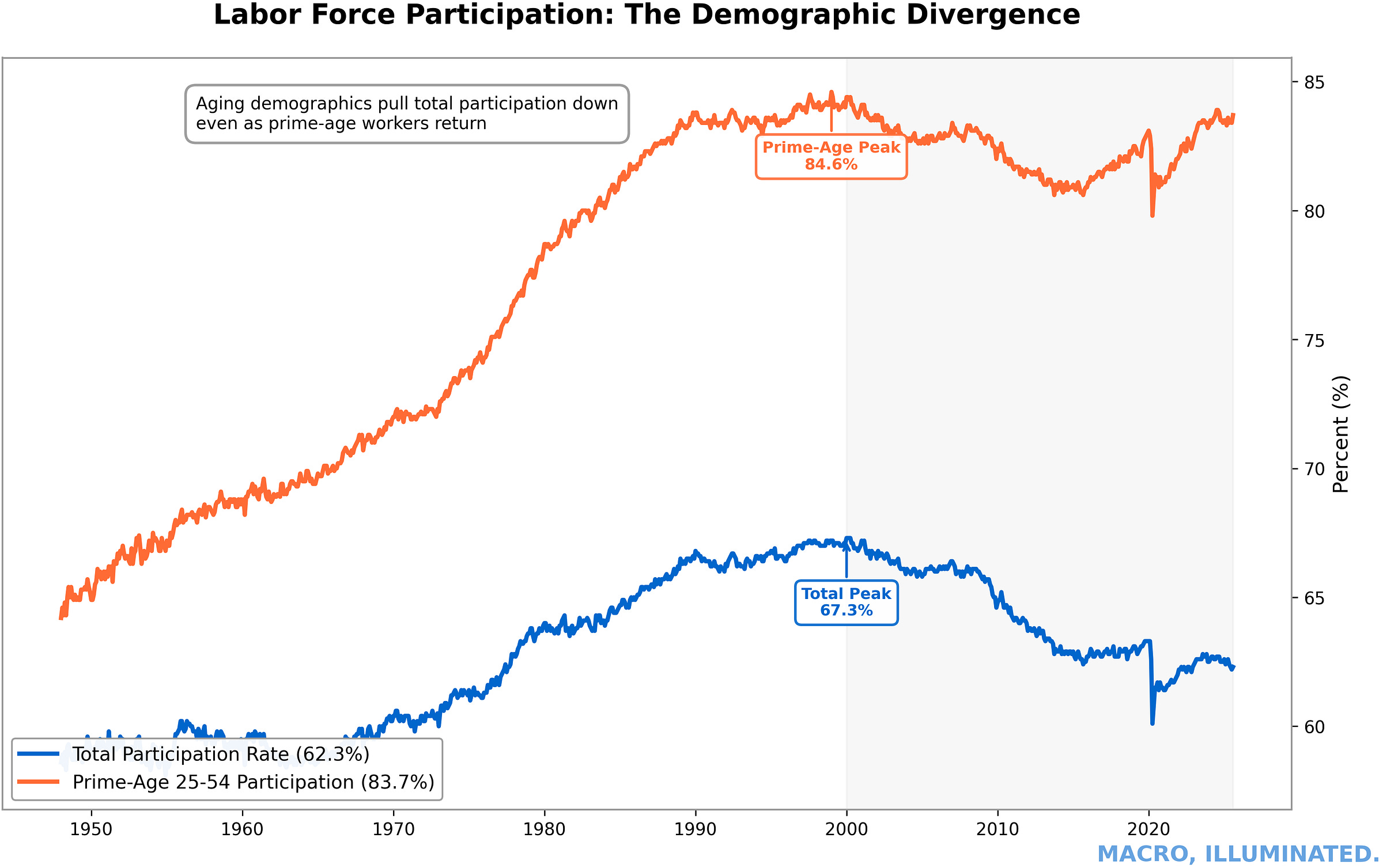
Chart 15: Labor Force Participation — The Demographic Divergence Prime-age participation has recovered to record highs while total participation remains structurally depressed due to Baby Boomer retirements, creating a persistent floor under wage growth that constrains disinflation.Prime-age labor force participation (ages 25-54) has rebounded to near record highs, around 83.7%. But total labor force participation remains depressed near 62.3%, well below the pre-pandemic level of 63.4% and far below the 2000 peak of 67.3%.
The gap reflects aging demographics. Baby Boomers are retiring en masse, shrinking the labor force even as prime-age workers return. The structural decline in total participation reduces potential labor supply, keeping labor markets tighter than historical unemployment rates would suggest.
This demographic headwind is persistent — it doesn’t reverse cyclically. Even if unemployment rises modestly in a mild recession, the underlying labor supply constraint from aging demographics remains. This creates a structurally higher floor for wage growth, making it harder for inflation to return to the 2% target without sustained above-trend unemployment.
7. The Paths Ahead
Four plausible scenarios define the range of outcomes for inflation, policy, and markets over the next 12-24 months.
Scenario 1: Soft Landing
Inflation returns to the 2% target without a recession. The labor market cools gradually — unemployment rises modestly to 4.5%, wage growth decelerates to 3%, and services inflation follows suit. The Fed cuts rates back toward neutral (3.5-4.0%), real rates ease, and growth stabilizes near trend.
This is the market’s base case, priced into equities, credit, and rates. But soft landings are historically rare. The economy must thread a narrow needle — cooling just enough to bring inflation down, but not so much that it tips into recession.
Implications:
Equities remain supported; risk assets stabilize
Fed cuts gradually toward neutral (3.5-4.0%)
Inflation settles near 2.0-2.5%
Scenario 2: Inflation Rekindling
Premature policy easing or new external shocks reignite inflation. Wage growth re-accelerates, services inflation stabilizes near 4%, and headline CPI rebounds above 3.5%. The Fed is forced to hike again or hold rates higher for longer than markets expect.
Catalysts could include: expansionary fiscal policy (tax cuts, spending increases), another energy shock (Middle East conflict escalation, OPEC+ supply cuts), or a sharp rebound in goods demand if monetary policy eases too quickly.
Tariff policy represents a particularly salient near-term risk. The incoming administration has signaled intentions to implement a 10-20% universal baseline tariff on all imports, with 60% rates on Chinese goods specifically. Historical pass-through analysis suggests 50-100% of tariff costs transmit to consumer prices depending on demand elasticity and competitive market structure. With U.S. imports totaling approximately $3.8 trillion annually and China still representing 13-15% of the total despite recent declines, broad-based tariff implementation could add 0.5-1.5 percentage points to goods CPI within 6-12 months of enactment. This would directly reverse the goods disinflation documented in Section 4.1, complicating the last mile considerably. The timing, magnitude, and sector-specific application remain uncertain—tariffs may serve as negotiating leverage rather than enacted policy—but the asymmetric risk skews toward goods inflation rekindling rather than further deflation. Retaliation from trading partners (EU, China countermeasures) could amplify the shock through exchange rate channels and supply chain disruptions.
Implications:
Fed hikes or extends the restrictive stance
Rates markets reprice higher
Growth slows as policy stays tight; equities correct
Scenario 3: Hard Landing
Overtightening drives inflation below target and pushes unemployment sharply higher. The Fed has waited too long to ease, financial conditions tighten excessively, credit markets freeze, and the economy tips into recession. Unemployment rises to 5.5-6.0%, inflation undershoots 2%, and the Fed is forced into aggressive rate cuts.
This scenario reflects the historical pattern: the Fed rarely achieves soft landings. More often, it tightens until something breaks — either inflation reignites, or the economy collapses.
Implications:
Recession; unemployment rises sharply
Fed cuts aggressively toward zero
Risk assets sell off; equities enter bear market
Scenario 4: New Normal — 3% Inflation Equilibrium
Inflation stabilizes near 3%, and markets gradually accept this as the new equilibrium. Structural forces — deglobalization, energy transition costs, demographic labor shortages — keep inflation persistently above the 2% target. The Fed adjusts its framework, implicitly tolerating 3% inflation rather than engineering a recession to hit 2%.
This outcome would require a fundamental repricing of policy expectations, bond yields, and equity valuations. Real rates would remain structurally higher, fiscal space would stay constrained, and asset prices would adjust to reflect the higher inflation regime.
Implications:
Fed implicitly accepts 3% inflation
Bond yields reprice higher; real rates stay elevated
Equity multiples compress as discount rates rise
Market Consensus vs. Policymaker Signaling:
Markets are pricing Scenario 1 (soft landing) with 60-70% confidence. Policymakers signal caution, emphasizing “higher for longer” and data-dependence. The gap between market pricing and Fed rhetoric suggests either the market is too optimistic or the Fed will surprise with earlier cuts.
The tail risks — Scenarios 2 and 3 — remain material. Inflation rekindling or a hard landing recession are lower-probability but high-impact outcomes that could reshape the macro landscape.
8. Illumination and Uncertainty
The easy phase of disinflation is over. Goods prices have reversed from boom to deflation. Supply chains have healed. Energy shocks have faded. What remains — the last mile — is the hardest part.
Services inflation, shelter costs, wage pressures, and structural demographic constraints define this final stretch. Whether inflation returns to 2% or stabilizes near 3% will determine the trajectory of monetary policy, fiscal sustainability, and asset valuations for the next cycle.
The 2020s have shattered the assumptions that anchored the 2010s. Inflation is no longer a dormant relic — it has returned as the central constraint on policy and growth. The Phillips curve, dismissed as obsolete, has reasserted itself. Labor market slack matters again. Real rates are positive, not negative. Fiscal space is limited, not abundant.
Policymakers are attempting an unprecedented feat: engineer a soft landing after the fastest tightening cycle in 40 years, against a backdrop of structural inflation pressures from deglobalization, energy transition, and aging demographics. History suggests this is a low-probability outcome, but it’s not impossible.
Markets have priced in the optimistic scenario. The key question for investors: is that consensus correct, or is the market underestimating the difficulty of the last mile?
Final Takeaways:
Goods disinflation is complete; services and wages dominate the last mile
Inflation near 3% vs. 2% reshapes the entire policy and market landscape
The last mile is the hardest mile — and the outcome remains uncertain
See you tomorrow for the first edition of The Beam.
Lighthouse Macro | Macro, Illuminated.
Disclaimer: This report is for informational and educational purposes only and does not constitute financial advice. The views expressed are those of the author and do not necessarily reflect the views of Lighthouse Macro or its affiliates. Past performance is not indicative of future results. All investments carry risk, including possible loss of principal. Readers should conduct their own research and consult with qualified financial advisors before making investment decisions.
About Lighthouse Macro
Lighthouse Macro provides institutional-quality macroeconomic research and cross-asset market analysis for hedge funds, CIOs, central bankers, and sophisticated retail traders. Founded by Bob Sheehan, CFA, CMT, our research bridges the gap between academic rigor and practical trading insights.
Our approach integrates:
Macroeconomic Analysis: Growth, inflation, labor, capital flows
Monetary Mechanics: Central bank policy, credit cycles, liquidity
Market Technicals: Price structure, positioning, sentiment
Cross-Asset Dynamics: Rates, credit, FX, equities, commodities, crypto
We treat macro variables as interconnected feedback loops, not isolated silos — balancing an economist’s structural lens with a trader’s focus on price expression and risk/reward asymmetries.
Publishing Schedule:
Sundays: The Beacon (deep dives on major macro themes)
Tuesdays & Thursdays: The Beam (concise chart-led insights)
Fridays: The Chartbook (weekly data and market summary)
First Monday of Each Month: The Horizon (forward-looking cross-asset outlook)
Follow Lighthouse Macro:
Website: Lighthouse Macro
Twitter/X: @LHMacro

